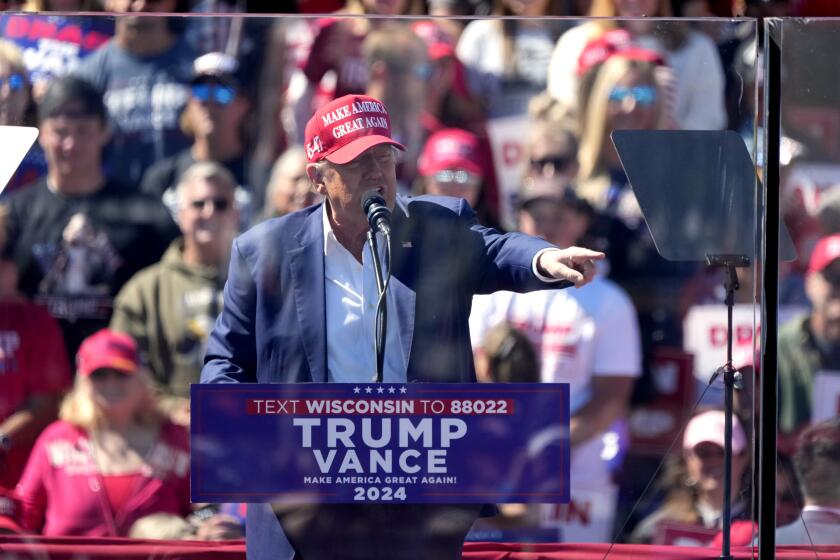A mixed record
The Supreme Court term that ended last week will be remembered for several important decisions. The court ruled that juveniles couldn’t be imprisoned for life without parole for any crime but homicide, that the individual’s right to bear arms must be respected by the states as well as by the federal government, and that a law used in white-collar and political corruption prosecutions was too vague. Some of the most significant rulings, however, involved the free-speech provisions of the 1st Amendment. They are a reminder that the apparently simple language of that amendment — “Congress shall make no law … abridging the freedom of speech” — depends for its definition on the court.
The best-known and most controversial 1st Amendment decision of the term was the Citizens United case, in which the court upended decades of restrictions on election spending by corporations and unions. The decision, which was denounced by President Obama and has loomed large in the confirmation hearings of Supreme Court nominee Elena Kagan, ostensibly was about whether a nonprofit group that received some money from corporations could air a documentary critical of Hillary Rodham Clinton during the 2008 presidential primary season. Instead of resolving that issue narrowly, the conservative majority of the court unnecessarily decided that corporations had a 1st Amendment right to spend their own funds on political advertising. One can disagree with the decision — as we did — and still note that it continued a tradition of the court imposing the strictest scrutiny on laws challenged on 1st Amendment grounds.
Another far-reaching decision involved what seemed to be a fringe issue: whether Congress could outlaw the sale of videos depicting cruelty to animals. In fact, the case presented the court with an opportunity — which it rightly declined — to create a new category of speech that, like child pornography, would be totally outside the protection of the 1st Amendment.
The 8-1 decision showed the Supreme Court at its best: ruling that even a well-intended and popular law swept too broadly and could lead to restrictions on expression protected by the 1st Amendment. Rejecting the government’s argument that the constitutionality of a form of expression depends on its value to society, Chief Justice John G. Roberts Jr. offered this eloquent defense of the 1st Amendment, one that will resound in future cases far removed from the world of dogfighting: “The 1st Amendment’s guarantee of free speech does not extend only to categories of speech that survive an ad hoc balancing test of relative social costs and benefits. The 1st Amendment itself reflects a judgment by the American people that the benefits of its restrictions on the government outweigh the costs. Our Constitution forecloses any attempt to revise that judgment simply on the basis that some speech is not worth it.”
In two other cases, however, majorities of the court gave disappointingly short shrift to 1st Amendment values.
In one, the court departed not only from its traditional protections of free speech but also from its recent role, in cases involving Guantanamo Bay, of insisting that the war on terror honor civil liberties. In this case the overreaching by government took the form of an overbroad interpretation of a law making it a crime to provide “material support” to foreign terrorists.
Accepting an argument by the Obama administration, the court ruled that material support can include advising terrorist groups to pursue their objectives peacefully. Conservatives on the court, joined by Justice John Paul Stevens, rejected the free-speech claims of activists who wanted to advocate nonviolence to Kurdish nationalists in Turkey and the Tamil Tigers in Sri Lanka. The defense of the 1st Amendment was left to the dissenters, led by Justice Stephen G. Breyer. Breyer would have interpreted the law to criminalize speech and association otherwise protected by the 1st Amendment “only when the defendant knows or intends that those activities will assist the organization’s unlawful terrorist actions.”
Finally, last week the court — with Justice Anthony M. Kennedy joining the four liberal justices — rejected a Christian student group’s claim that the UC Hastings College of Law discriminated against it by refusing to provide it with official recognition. The university initially said that the Christian Legal Society was denied recognition because it wouldn’t abide by a university policy prohibiting discrimination on the basis of religion and sexual orientation. The society countered that it was being singled out because of a code of conduct that required members to abstain from sex outside heterosexual marriage. (Later the school insisted that it had an “all comers” policy requiring all student groups to admit any applicant.)
Protecting the 1st Amendment rights of unpopular groups, including religious groups, has been the theme of multiple Supreme Court decisions. As recently as 1995, in a case involving the University of Virginia, the court made it clear that state schools may not deny religious groups access to activity fees available to other student groups. This term the court endorsed what the dissenters called “a very different principle: no freedom for expression that offends prevailing standards of political correctness in our country’s institutions of higher learning.”
Freedom of expression is perennially under attack from the left, right and center of the political spectrum. One of the court’s highest purposes is to hold high the central role of the 1st Amendment in protecting liberties of all kinds. In fulfilling that function this term, the court compiled a mixed record at best.
More to Read
Sign up for Essential California
The most important California stories and recommendations in your inbox every morning.
You may occasionally receive promotional content from the Los Angeles Times.










